You searched for: 海外商城系统源码快速搭建【TG���������@EK7676】平台包网搭建海外商城系统源码快速搭建【TG���������@EK7676】平台包网搭建19Ez42Yfxf
<< Previous | Displaying results 1-25 of 177 for "海外商城系统源码快速搭建【TG���������@EK7676】平台包网搭建海外商城系统源码快速搭建【TG���������@EK7676】平台包网搭建19Ez42Yfxf" | Next >>
-
Judges in the trial of Dora-Mittelbau personnel
PhotoJudges in the trial of 19 men accused of committing atrocities at the Dora-Mittelbau concentration camp, located near Nordhausen. Dachau, Germany, September 25, 1947.
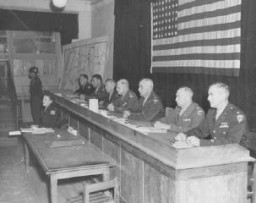
-
Defendants on trial for committing atrocities at the Dora-Mittelbau camp
PhotoA group of the 19 men accused of committing atrocities at the Dora-Mittelbau concentration camp, located near Nordhausen, during their war crimes trial. Dachau, Germany, September 19, 1947.

-
An emaciated woman selling Star of David armbands
PhotoAn emaciated woman sells the compulsory Star of David armbands for Jews. In the background are concert posters; almost all are destroyed. Warsaw ghetto, Poland, September 19, 1941. This photograph was taken by Heinrich Joest, a German army sergeant during World War II. On September 19, 1941, he took 140 images of every aspect of life and death in the Warsaw ghetto.
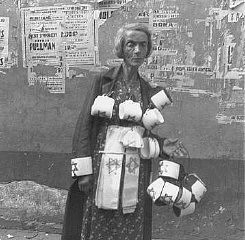
-
Railcar
PhotoView of the railcar on display in the Permanent Exhibition of the United States Holocaust Memorial Museum. Washington DC, June 19, 1991. Courtesy of Polskie Koleje Panstwow S.A.
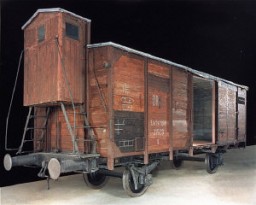
-
Graffiti on a Jewish-owned store
PhotoWindows of a Jewish-owned store painted with the word Jude (Jew). Berlin, Germany, June 19, 1938.
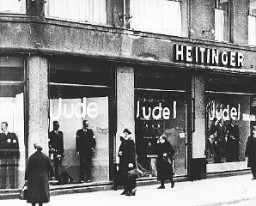
-
The Warsaw Ghetto Uprising
ArticleThe Warsaw ghetto uprising was the largest uprising by Jews during World War II. 100s of ghetto fighters fought heavily armed and well-trained Germans for nearly a month.
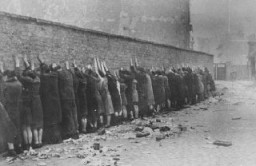
-
The 69th Infantry Division during World War II
ArticleThe 69th Infantry Division participated in major WWII campaigns and is recognized for liberating the Leipzig-Thekla subcamp of Buchenwald in 1945.
-
A captured Jewish resistance fighter
PhotoA captured Jewish resistance fighter who was forced out of his hidden bunker by German soldiers during the Warsaw ghetto uprising. Warsaw, Poland, April 19-May 16, 1943.

-
Scene during the Warsaw ghetto uprising
PhotoGerman soldiers direct artillery against a pocket of resistance during the Warsaw ghetto uprising. Warsaw, Poland, April 19-May 16, 1943.
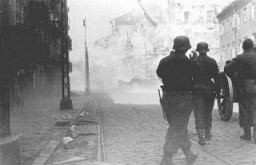
-
Destruction during the Warsaw ghetto uprising
PhotoGerman soldiers burn residential buildings to the ground, one by one, during the Warsaw ghetto uprising. Poland, April 19-May 16, 1943.
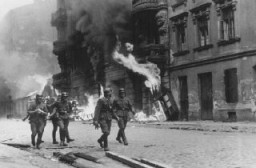
-
Jews captured during the Warsaw ghetto uprising
PhotoJews captured during the Warsaw ghetto uprising. Poland, April 19–May 16, 1943.

-
Adolf Hitler enters Danzig
PhotoSaluting Germans greet Adolf Hitler (standing at front of car) as he enters Danzig. The Danzig District was incorporated into Greater Germany following the invasion of Poland. Danzig, September 19, 1939.
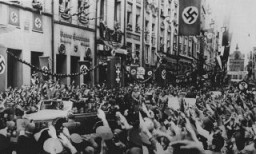
-
Occupation of Danzig
PhotoAdolf Hitler addresses German officers after the occupation of Danzig. Even before the surrender of Poland, Hitler affirmed the incorporation of the Danzig District into the Greater German Reich. Danzig, September 19, 1939.
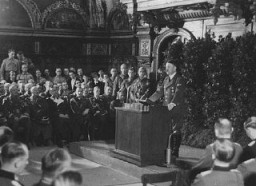
-
Juergen Stroop
PhotoJuergen Stroop (third from left), SS commander who crushed the Warsaw ghetto uprising. Warsaw, Poland, between April 19 and May 16, 1943.
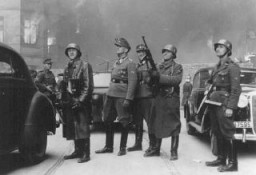
-
Elie Wiesel speaks at a conference
PhotoElie Wiesel speaks at the Faith in Humankind conference, held before the opening of the United States Holocaust Memorial Museum, on September 18–19, 1984, in Washington, DC.
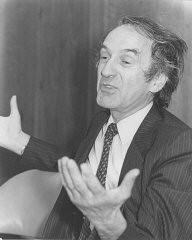
-
Elie Wiesel speaks at the Faith in Humankind conference
PhotoElie Wiesel speaks at the Faith in Humankind conference, held several years before the opening of the United States Holocaust Memorial Museum. September 18–19, 1984, in Washington, DC.
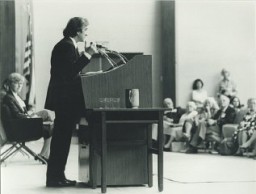
-
Poking Pine City Displaced Persons Camp
ArticleAfter WWII, many Holocaust survivors, unable to return to their homes, lived in displaced persons camps in Germany, Austria, and Italy. Read about Poking Pine City DP camp.
-
Fürstengrube
ArticleLearn about Fürstengrube subcamp of Auschwitz, including its establishment, administration, prisoner population, and forced labor and conditions in the camp.
-
Warsaw Ghetto Uprising
ArticleThe Warsaw ghetto uprising was the largest, symbolically most important Jewish uprising, and first urban uprising in German-occupied Europe.

-
Adolf Eichmann: Key Dates
ArticleAdolf Eichmann was a key figure in implementing the “Final Solution,” the Nazi plan to kill Europe's Jews. Learn more through key dates and events.
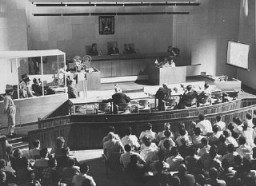
-
The Nuremberg Code
ArticleLeading German physicians and administrators were put on trial for their role during the Holocaust. The resulting Nuremberg Code was a landmark document on medical ethics. Learn more
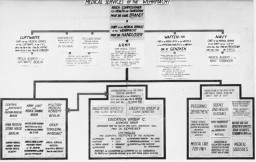
-
Belzec: Key Dates
ArticleExplore key events in the history of the Belzec killing center in the Nazi camp system. It was constructed for the sole purpose of murdering Jews.
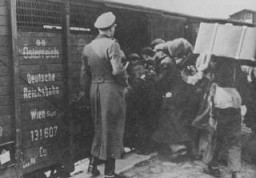
-
International Holocaust Remembrance Day
ArticleJanuary 27, anniversary of the liberation of Auschwitz, is designated by the United Nations General Assembly as International Holocaust Remembrance Day (IHRD).
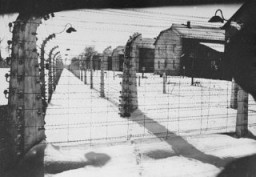
-
Eva Heyman: Maps
Media EssayEva was born to Jewish parents and grew up in a city on the border between Romania and Hungary. On March 19, 1944, the Germans occupied Hungary and Eva was soon forced into a ghetto. She was later deported to Auschwitz, where she was killed at the a...
-
Jeno Brieger: Maps
Media EssayJeno Brieger was born to a Jewish family in northeastern Hungary. The Germans occupied Hungary on March 19, 1944. Jeno was forced into a ghetto and then deported to Auschwitz and Bergen-Belsen, where he was liberate...
